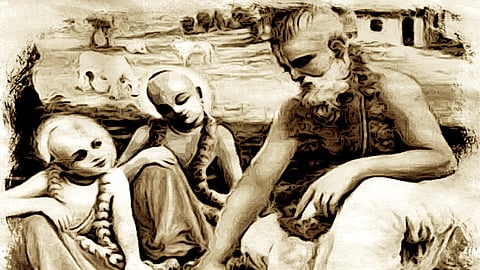- Commentary
- History Vignettes
- Notes on Culture
- Dispatches
- Podcasts
- Indian LanguagesIndian Languages
- Support

As we remarked in the introduction to this series, the author of this fine white paper wrote it in extremely turbulent and difficult times. The system of education that he advocates exited as an unbroken national institution almost since the dawn of the Sanatana civilization. It had survived intact in spite of several repeated and brutal onslaughts first from the alien Muslim invaders and flourished in many places even under the prolonged Islamic rule during the medieval period.
However, as we have noted on numerous occasions in The Dharma Dispatch, in just half a century, the British education system not only destroyed this system of education but created several generations of Hindus who were aliens to their own culture and strangers in their own homes. In 1902, when the author wrote this essay, traditional Gurukulas were still a respected source of education, especially in our enlightened Princely States like Mysore, Baroda, Bikaner, and Travancore. This makes the essay even more vital because as we can now verify, the author anticipated the coming disaster if the situation was not urgently rectified.
Unfortunately, it appears that the British education system ultimately won, given the fact that even today, we have been unable to decolonize education in India.
Do read this final part of the series.
In India, we have always insisted that religion consists in living the life prescribed and not in oral teaching, and not in carrying around the temper and tastes of the battle-field wherever one goes. The only proper system of religious education for Hindu students is primarily not of class instruction, but of training and discipline in the spiritual life as conceived by the divine sages who have revealed to us the Sanatana Dharma as contained in the Sruti, Smriti, Ithihasa, and Purana.
In every town and village, societies must be founded and teachers appointed and paid for the purpose of carrying out the injunctions of the Shastras according to approved methods and without clashing with the requirements of our age. While the spirit of the ancient system of discipline and instruction is maintained, necessary changes of form, method, time, and place must be made in the light of practical experience. The teachers must be properly and carefully chosen and each must be assigned a manageable number of pupils. Courses of training, curricula of studies, and timetables must be prepared by the societies formed in the various localities, and an effective supervision and control must be organised. Provision must be made in this organisation for young men of all Varnas and sects according to their religious views, principles, and traditions. But no pains must be spared in bringing about a practical spirit of sincere devotion to religious duties and of love to Ishwara and man.
In India, the introduction of this system of training and discipline in the life of the spirit is easy, for it even now exists though in a greatly decayed and neglected condition.
Europe has become the chosen home of materialism, agnosticism, and scientific atheism. The other day, Mr. W. T. Stead wrote:
In India alone, there is no unnatural divorce between philosophy and religion. There is no philosophy without religion, and, as Swami Vivekananda insists, “religion is realisation.”
Let us, then, endeavour to get our youths in hand betimes and take all proper steps to have them trained in the practice of the preliminary Aryan gospel of discipline in accordance with the declared injunctions of the sages. The actual oral teaching can easily be given side by side according to the requirements of the individual pupils, and there is really very little use ill entering upon elaborate courses of polemics without the necessary preparatory and purificatory discipline.
In the Western world today, men have ceased to believe that the essential core of religion lies in looking inward. T he Christian Church has interposed its own extraordinary misapprehensions and misrepresentations of the truth concerning true spirituality and its present function is to help in the spread or maintenance of European mercantile and military predominance.
Mathew Arnold has said, “conduct is three-fourths of life.” However, in the Hindu view, conduct is the whole of life.
Sanatana Dharma and philosophy are intended to enable man to realise the eternal nature of the soul. This realisation is possible even while on earth to those who have attained the necessary stage and altitude of spiritual elevation.
Concluded
The Dharma Dispatch is now available on Telegram! For original and insightful narratives on Indian Culture and History, subscribe to us on Telegram.
